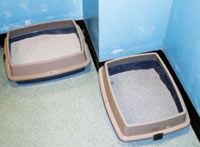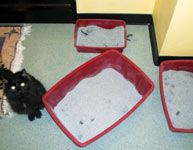The latest scoop on litter
Dr. Jacqueline Neilson highlights research on cats' litter and litter box preferences.
While cats are the most popular pet in the United States,1 their most common behavioral problem for which owners seek assistance, housesoiling, is unpopular with their owners. In fact, housesoiling can lead to a cat's outdoor banishment, relinquishment, or euthanasia. Studies support this regrettable outcome, with behavioral problems—primarily housesoiling—being a leading cause of cats' relinquishment to shelters.2 In one study, more than 23% of cats relinquished to a shelter had daily or weekly housesoiling incidents.3 A recent study found that the most common problem identified after the adoption of a cat from a shelter was housesoiling, with 9% of the cats in the study exhibiting this behavior within three months of adoption.4 The study also identified housesoiling as a risk factor for returning the adopted cat to the shelter.4

(Glenn Reid)
There are three main causes of housesoiling in cats: underlying medical problems (e.g. feline lower urinary tract disease [FLUTD]), urine marking (communication), and toileting issues (e.g. litter box aversions, preferences for other sites or substrates). These diagnoses are not mutually exclusive; for example, a cat with FLUTD may develop a litter box aversion. Evaluating a thorough history and the results of a physical examination and diagnostic tests can direct the diagnosis and subsequent treatment.
In addition, toileting problems can stem from a variety of causes. Many toileting issues are secondary to issues with the litter or litter box. But a toileting problem can also stem from factors that are unrelated to the litter or litter box, such as intercat aggression. For example, a cat that is frightened of other cats in the home may feel vulnerable accessing or using the litter box and may ultimately select an inappropriate toileting site. So again, it is always critical to get a comprehensive history to correctly identify the motivation for the problematic behavior.
This article focuses on new research related to litter and litter boxes that may be helpful in preventing and treating toileting problems. By getting the latest scoop on litter, you will be better prepared to prevent and resolve litter- and litter-box-related toileting problems in your feline patients.
HISTORICAL CONSIDERATIONS
Litter preferences probably originated with the domestic cat's evolutionary predecessor, Felis silvestris lybica, the African wildcat.5 A desert-dwelling creature, the African wildcat used the desert sand as its toilet, establishing a substrate preference that has apparently persisted throughout the domestication process.
With the transition of cats into our homes and the need to provide an adequate indoor toileting option, commercial litters were developed. As different options appeared on the market, preference tests for various litter types were conducted on cats. A study in the early 1990s identified cats' strong preference for finely granular sandlike material, widely known as clumping or scoopable litter, compared with large-granule litter, such as litter made of plain clay or recycled paper products.6 As new litters have entered the market, such as silica (crystal) litters, a preference for clumping litter has continued to prevail in comparative studies.7
LITTER TODAY
The litter market offers a wide variety of litters, including litters made of wheat, corn, paper, silica, and plain or clumping clay. Within each of these litter categories are several brands or varieties with different additives. For example, the basic component of clumping clay litter is sodium bentonite, clay made from volcanic ash. Multiple ingredients may be added to the sodium bentonite base, including fragrances, fillers, bacterial growth inhibitors, and absorption additives, to create a unique litter product. In general, the best litter products have a substrate that cats like the feel of, provide superior odor control, and have minimal dust.
LITTER FRAGRANCE
The impact of fragrance on cats' litter preference is unclear. In one study, scented litter was a risk factor for elimination problems,8 but in another study, scented litter was not associated with elimination problems.9 Nevertheless, if cats with housesoiling problems are being offered scented litter, advise owners to try offering nonscented litter.
Both the aroma and intensity of a fragrance may be a factor in a cat's response to it. Little published information on scent preferences in cats is available, but a 2007 pilot study with seven cats showed that cats preferred (by exhibiting increased engagement behaviors [e.g. sniffing]) cedar and fish odors and showed avoidance behaviors to citrus and floral scents.10
A follow-up study with 18 cats and a modified scent palate that included bleach, cedar, citrus, fish, and floral scents showed that cats preferred bleach and fish scents to the other offered scents.11 These fragrances were not presented in the context of litter or elimination, and in that context, the results may be different. I hope that future research will elucidate a litter fragrance that is pleasing to both owners and cats.
ODOR CONTROL
Cats may consider a heavily soiled box aversive, perhaps because of the strong malodor associated with excrement. While daily scooping and discarding of solid waste are strongly advised, additional techniques to control urine and fecal odor are desirable.
Activated carbon has been incorporated into some litters in an attempt to reduce fecal odor. While people can readily appreciate the effectiveness of activated carbon in odor reduction, a study was conducted to see if cats preferred litter with activated carbon to litter without activated carbon. The results showed that cats preferentially used the litter with the activated carbon,12 suggesting that it may help in preventing and treating litter box problems.
Another study was performed comparing two litter odor-control additives, activated carbon and sodium bicarbonate.13 These odor-control additives are used in two top-selling national litter brands. About 32 cats (the number of cats varied because of adoptions) housed in four colony rooms at a shelter were given access in each room to two litter boxes and two base litters that were identical except for the odor-control additives (Figure 1). Excrement was collected from the boxes each morning after four consecutive 12-hour overnight test periods. The amount of excrement was analyzed by using both parametric (analysis of variance [ANOVA]) and nonparametric (Friedman) tests, using a randomized block design. The cats showed significant (P < 0.05) increased usage of the litter box with the activated carbon additive, suggesting that the cats preferred activated carbon to sodium bicarbonate as an odor-control additive.

Figure 1. Litter boxes prepared for the odor-control study comparing activated carbon vs. sodium bicarbonate additives. The litter boxes were identical except for the litter odor-control additives. The litter boxes were rotated every 12 hours to remove location preference.
A similarly designed study involving about 32 cats housed in four rooms and using two commercially available products, Fresh Step Scoopable (The Clorox Company) with activated carbon and Arm & Hammer Super Scoop (Church & Dwight) with sodium bicarbonate, was conducted (Figure 2). Unlike the previous study in which the base litter was identical, these two commercial products not only had different odor-controlling agents but also had different fragrances and fillers. More excrement was deposited in the litter box containing Fresh Step Scoopable litter, and the difference was statistically significant (P = 0.031), suggesting that the cats preferred this litter product (Neilson J, Portland, Ore: Unpublished data, 2008).

Figure 2. Litter boxes prepared for the Fresh Step Scoopable vs. Arm & Hammer Super Scoop study (one pair of boxes was not included in the study). The boxes were identical except for litter.
BOX SIZE
It has been hypothesized that one cause of feline toileting problems is litter box aversion due to small box size. Some experts recommend that litter boxes should be 1 ½ times the cat's body length; however, to my knowledge, no evidence supports this claim aside from anecdotal reports and common sense. Consequently, I conducted a study to identify if cats had a preference for a certain box size when all other variables were equal.14 To determine litter box size preference, 32 cats housed in four colony rooms in a shelter were given access in each room to three commercially purchased plastic litter boxes equal in every parameter except size (Figure 3). The boxes were small (14-x-10-x-3.5-in), medium (18-x-15-x-5-in), and large (22-x-16-x-6.5-in) in size. The same commercial clumping clay litter was used in all boxes. The study was conducted over 21 hours. Excrement deposited in the boxes was collected every two hours during the daytime and in the morning, and the excrement was then counted, weighed, and recorded. Again, the data for each room were analyzed by using parametric (ANOVA) and nonparametric (Friedman) tests. Although statistical significance was not achieved, the trend was that the cats preferred the large boxes to the medium and small boxes based on the number of deposits and total weight of excrement.

Figure 3. Small, medium, and large litter boxes in the colony room for the litter box size preference study. The litter was identical in all boxes, and the boxes were rotated throughout the course of the study to remove location preference.
OVERALL RECOMMENDATIONS
It is in everyone's best interest to identify a litter and litter box environment pleasing to cats. Research and product development will continue to advance and identify superior litter products, but it is important for practitioners to provide evidence-based advice to cat owners regarding litter and litter boxes so toileting problems are minimized.
When providing that advice, remember that cats prefer clumping litters and litters with activated carbon. If a fragranced litter is going to be used, data suggest cats prefer a cedar scent to other scents. I caution owners against purchasing citrus-scented litters, which are becoming more prevalent in the marketplace. Finally, based on the trends noted in the box size study, I recommend that practitioners advise owners to purchase large or jumbo-sized litter boxes for their cats or even consider purchasing large plastic storage boxes to use as litter boxes.
Of course, it is important to remember that you may encounter cats with unique preferences. The best way to identify an individual cat's set of toileting preferences is to offer a variety of litter choices and box styles and retain the litter and litter boxes that the cat preferentially uses. It is also wise to remind clients that no odor-controlling litter ingredients can substitute for daily litter box scooping and regular box washing.
Editors' Note: Dr. Neilson has received research funding from The Clorox Company, makers of Fresh Step litter.
Jacqueline C. Neilson, DVM, DACVB
Animal Behavior Clinic
809 S.E. Powell Road
Portland, OR 97202
REFERENCES
1. American Veterinary Medical Association. U.S. pet ownership and demographics sourcebook. Schaumburg, Ill:AVMA, 2007.
2. Salman MD, Hutchison J, Ruch-Gallie R, et al. Behavioral reasons for relinquishment of dogs and cats to 12 shelters. J Appl Anim Welf Sci 2000;3(2):93-106.
3. Patronek GJ, Glickman LT, Beck AM, et al. Risk factors for relinquishment of cats to an animal shelter. J Am Vet Med Assoc 1996;209(3):582-588.
4. Marder AR, Engel JM, Hekman JP. Feline behaviour problems reported by owners after adoption from an animal shelter, in Proceedings. 6th Int Vet Behav Meet and Eur Coll Vet Behav Med–Companion Anim Eur Soc Vet Clin Ethology 2007;138-139.
5. Clutton-Brock JA. A natural history of domesticated mammals. 2nd ed. Cambridge, UK: Cambridge University Press, 1999.
6. Borchelt PL. Cat elimination behavior problems. Vet Clin North Am Small Anim Pract 1991;21(2):257-264.
7. Neilson JC. Pearl vs. clumping: litter preference in a population of shelter cats, in Proceedings. Am Vet Soc Anim Behav 2001;14.
8. Horwitz DF. Behavioral and environmental factors associated with elimination behavior problems in cats: a retrospective study. Appl Anim Behav Sci 1997;52:129-137.
9. Sung W, Crowell-Davis SL. Elimination behavior patterns of domestic cats (Felis catus) with and without elimination behavior problems. Am J Vet Res 2006;67(9):1500-1504.
10. Neilson JC. Scent preferences in the domestic cat, in Proceedings. 6th Int Vet Behav Meet and Eur Coll Vet Behav Med–Companion Anim Eur Soc Vet Clin Ethology 2007;171-172.
11. Neilson JC. Scent preferences in the domestic cat, in Proceedings. Am Coll Vet Behav/Am Vet Soc Anim Behav 2008 Scientific Paper and Poster Session 2008;42-45.
12. Neilson JC. Litter preference test: evaluating carbon enhanced litter, in Proceedings. Am Coll Vet Behav/Am Vet Soc Anim Behav 2007 Scientific Paper and Poster Session 2007;59-60.
13. Neilson JC. Litter odor control: carbon vs. bicarbonate of soda, in Proceedings. Am Coll Vet Behav/Am Vet Soc Anim Behav 2008 Scientific Paper and Poster Session 2008;31-34.
14. Neilson JC. Is bigger better? Litterbox size preference test, in Proceedings. Am Coll Vet Behav/Am Vet Soc Anim Behav 2008 Scientific Paper and Poster Session 2008;46-49.
Inhaled albuterol offers more accessible treatment option for elevated potassium levels in cats
April 2nd 2025A recent study explored the effect of inhaled albuterol sulfate in reducing blood potassium levels in felines, which offers a potential treatment option for urinary obstruction-related hyperkalemia
Read More